
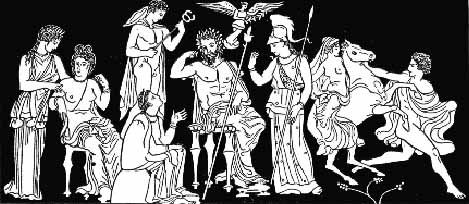


In Greek mythology, the Titans were a primeval race of powerful deities, descendants of Gaia (Earth) and Uranus (Heaven), that ruled during the legendary Golden Age. They were immortal giants of incredible strength and stamina and were also the first pantheon of Greco-Roman gods and goddesses.
In the first generation of twelve Titans, the males were Oceanus, Hyperion, Coeus, Cronus, Crius and Iapetus and the females - the Titanesses - were Mnemosyne, Tethys, Theia, Phoebe, Rhea and Themis. The second generation of Titans consisted of Hyperion's children Eos, Helios, and Selene; Coeus's daughters Leto and Asteria; Iapetus's sons Atlas, Prometheus, Epimetheus, and Menoetius; Oceanus' daughter Metis; and Crius' sons Astraeus, Pallas, and Perses.
The Titans later gave birth to other Titans, notably the children of Hyperion (Helios, Eos, and Selene), the daughters of Coeus (Leto and Asteria), and the sons of Iapetus - Prometheus, Epimetheus, Atlas, and Menoetius; all of these descendants in the second generation are also known as "Titans".
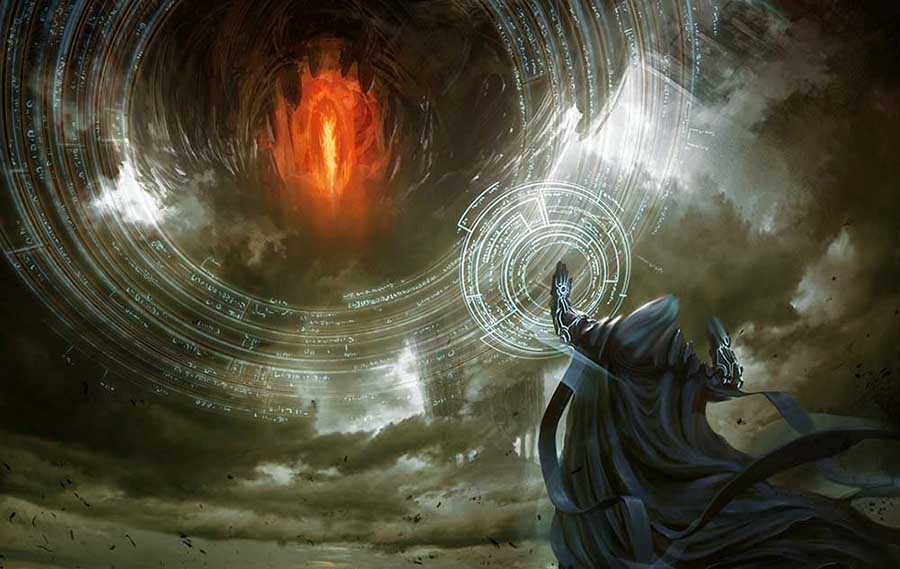
The Titans were overthrown by a race of younger gods, the Olympians, in a ten-year war called the Titanomachy ("War of the Titans") - a series of battles which were fought in Thessaly between the two camps of deities long before the existence of mankind. This Titanomachia is also known as the Battle of the Titans, Battle of Gods, or just The Titan War. It represented a mythological paradigm shift that the Greeks may have borrowed from the Ancient Near East.
The 12 Titans gods, also known as the elder gods. Their ruler was Cronus who was dethroned by his son Zeus. Most of the Titans fought with Cronus against Zeus and were punished by being banished to Tartarus.
Greeks of the Classical age knew of several poems about the war between the gods. The dominant one, and the only one that has survived, was in the Theogony attributed to Hesiod. A lost epic Titanomachy attributed to the blind Thracian bard Thamyris, himself a legendary figure, was mentioned in passing in an essay On Music that was once attributed to Plutarch. And the Titans played a prominent role in the poems attributed to Orpheus. Although only scraps of the Orphic narratives survive, they show interesting differences with the Hesiodic tradition.
These Greek myths of the Titanomachy fall into a class of similar myths of a War in Heaven throughout Europe and the Near East, where one generation or group of gods by and large opposes the dominant one. Sometimes the Elder Gods are supplanted. Sometimes the rebels lose, and are either cast out of power entirely or incorporated into the pantheon. Other examples might include the wars of the Aesir with the Vanir and Jotuns in Scandinavian mythology, the Babylonian epic Enuma Elish, the Hittite "Kingship in Heaven" narrative, and the obscure generational conflict in Ugaritic fragments. The rebellion of Lucifer from Christianity could also fall under this category.
In Hesiod's Theogony the twelve Titans follow the Hundred-handers and Cyclopes as children of Ouranos, heaven, and Gaia, the Earth. Ouranos considers Cronus monsterous, and so imprisons him in the bowels of the Earth. Cronus, aided by the Hundred-handers and Cyclopes, then sets upon his father, castrates him, and sets himself up as king of the gods, with Rhea as his wife and queen.
Rhea bears a new generation of gods to Cronus, but in fear that they will overthrow him, he swallows them all one by one. Only Zeus is saved: Rhea gives Cronus a stone in swaddling clothes in his place, and places him in Crete to be guarded by the Kouretes.
Once Zeus reaches adulthood, he subdues Cronus by force. Using a potion concocted with the help of Gaia, his grandmother, forcibly cause Cronus to vomit up Zeus's siblings. A war between the younger and many of older gods commences, in which Zeus is aided by the Hundred-handers, Gigantes, and Cyclopes, who have once again been freed from Tartarus. Zeus wins after a long struggle, and casts many of the Titans down into Tartarus.
And yet the older gods leave their mark on the world. Some of them - like Mnemosyne, Gaia, Rhea, Hyperion, Themis and Metis - had not fought the Olympians, and become key players in the new administration. The Titans also leave behind a number of offspring, some of whom may also be counted as Titans, most notably the sons of Iapetus - Prometheus, Epimetheus, Atlas, and Menoetius. Many ancient sources follow Hesiod closely, with minor variations: Apollodorus adds Dione as a thirteenth Titan.
Surviving fragments of Orphic poetry in particular preserve some variations on the myth.In one Orphic text, Zeus does not simply set upon his father violently. Instead, Rhea spreads out a banquet for Cronus, so that he becomes drunk upon honey. Zeus chains him and castrates him. Rather than being consigned to Tartarus, Cronus is dragged - still drunk - to the cave of Night, where he continues to dream and prophesy throughout eternity.
By and large Neopagan views of Titans can be considered 'New Age'. Many of the ancient myths are often conveniently reinterpreted as metaphor or seen as man's account of the divine. As such rather or not most modern beliefs regarding the Titans are grounded in actual mythology is often irrelevant to many Neopagans of today. In the United States Hellenistic Neopagan sects often have a special place for the Titan gods of ancient Greece, in particular Gaia, Cronus, Hecate, Hyperion, Theia, and Themis. It is sometimes argued that most of the beliefs regarding these Titan gods are inspired by popular fiction and entertainment media and not by actual mythology.
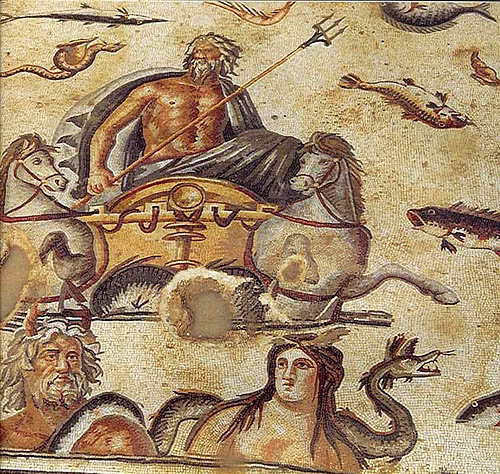
Oceanus or Okeanos refers to the ocean, which the Greeks and Romans regarded as a river circling the world. Strictly speaking, it was the ocean-stream at the Equator in which floated the habitable hemisphere In Greek mythology this world-ocean was personified as a Titan, a son of Uranus and Gaia. In ancient Greek beliefs this Titan is often depicted as having the upper body of a muscular man with a long beard and horns, and the lower torso of a serpent.
Oceanus' consort is his sister Tethys, and from their union came the ocean nymphs, also known as the three-thousand Oceanids, and all the rivers of the world.
Some scholars believe he originally represented all bodies of salt water, including the Mediterranean Sea and the Atlantic Ocean, the two largest bodies known to the ancient Greeks. However, as geography became more accurate, Oceanus came to represent the stranger, more unknown waters of the Atlantic Ocean (also called the Ocean Sea), while Poseidon ruled over the Mediterranean.
In most variations of the war between the Titans and the Olympians ("Titanomachy"), Oceanus, along with Prometheus, and Themis, did not take the side of his fellow Titans against the Olympians, but instead withdrew from the conflict. In most variations of this myth, Oceanus also refused to side with Cronus in the latter's revolt against their father, Uranus.
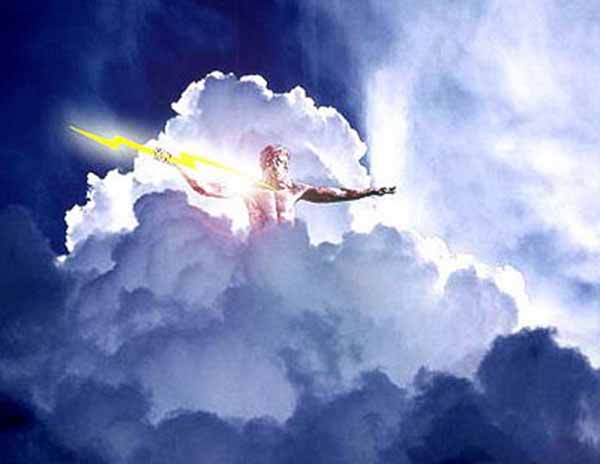
Hyperion was the Titan god of light, the father of the three shining gods of heaven - Eos the Light of Dawn and Day, Helios the Sun, and Selene the Moon.
In the Homer's Iliad and Odyssey the sun god is called Helios Hyperion, 'Sun High-one'. But in the Odyssey, Hesiod's Theogony and the Homeric Hymn to Demeter the sun is once in each work called Hyperonides 'Son of Hyperion' and Hesiod certainly imagines Hyperion as a separate being in other places.
Hyperion is often considered the 'God of Observation' and is the brother of Theia the 'Goddess of Sight.'
In later Greek literature Hyperion is always distinguished from Helios as a Titan, the son of Gaia 'Goddess Earth' and Uranus 'God Sky', and the father of Helios 'God Sun', Selene 'Goddess Moon' and Eos 'Goddess Dawn' by his sister Theia 'Goddess Sight'.
Hyperion plays virtually no role in Greek cult and little role in mythology, save in lists of the twelve Titans. Later Greeks intellectualized their myths.
Of Hyperion we are told that he was the first to understand, by diligent attention and observation, the movement of both the sun and the moon and the other stars, and the seasons as well, in that they are caused by these bodies, and to make these facts known to others; and that for this reason he was called the father of these bodies, since he had begotten, so to speak, the speculation about them and their nature.
Modern interpretations of Hyperion by Neopagans, particularly Hellenistic sects in the United States, include the interpretation that he is the all seeing, and subsequently all knowing, god of observation. Others believe that Hyperion holds ultimate reign over the positions of the stars and the heavens, and can at times reveal celestial messages to careful observers. Hyperion is seen as impartial and unconcerned with mortals.
Hyperion is believed to play a role in the final judgment of a mortal soul, particularly making observations about one's virtuous and ill deeds before Hades, and adding weight to the scales held by Themis.Some modern pagans burn oils and incense to Hyperion and pray for worldly knowledge, or in some cases extended sight. There are those who believe that extended sight is impossible to control, and that some things in the universe are beyond mortal comprehension and should remain unseen. Others claim that extended sight can include seeing into Tartarus (hell) and may result in madness, thus some sects discourage active worship of Hyperion. Most sects that include the worship of Hyperion also include the worship of Hecate, and more commonly Theia. Such sects typically encourage experimentation with the paranormal.

In Greek mythology, Coeus (also Koios) was the Titan of intelligence. was one of the Titans, the giant sons and daughters of Uranus (Heaven) and Gaia (Earth). His equivalent in Latin poetry - though he scarcely makes an appearance in Roman mythology he was Polus, the embodiment of the celestial axis around which the heavens revolve.
Like most of the Titans he played no active part in Greek religion - he appears only in lists of Titans - but was primarily important for his descendants. With his sister, "shining" Phoebe, Coeus fathered Leto and Asteria. Leto copulated with Zeus (the son of fellow Titans Cronus and Rhea) and bore Artemis and Apollo.
Along with the other Titans, Coeus was overthrown by Zeus and other Olympians. After the Titan War, he and all his brothers were banished into Tartarus by Zeus.
Koios (Coeus) was the Titan of the north, wisdom and farsight. He controlled the axis, and was released from Tartarus by Demeter's grief, changing the seasons. Coeus fled to the north from Zeus, and was regarded as the north star Polaris.
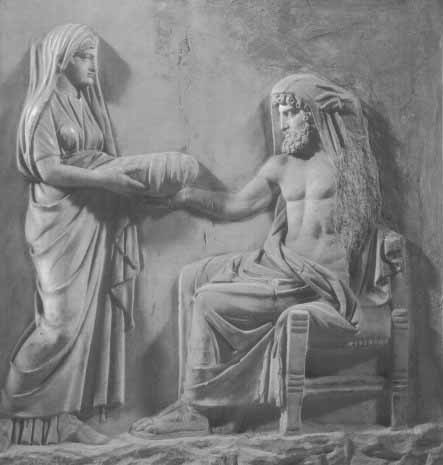
Cronus "horned"), also spelled Cronos or Kronos, is often confused with Chronos/Khronos.
In Greek mythology, Cronus was the leader and the youngest of the first generation of Titans. His mother was Gaia, and his father was Uranus, whom Cronus envied.
Uranus hid the youngest children of Gaia, the one-hundred armed giants (Hecatonchires) and the one-eyed giants, the Cyclopes, in Tartarus so that they would not see the light, rejoicing in this evil doing. This caused pain to Gaia, so she created a great sickle and gathered together Cronus and his brothers to ask them to obey her. Only Cronus was willing to do the deed, so Gaia gave him the sickle and set him in ambush. Cronus ambushed his father and castrated him, casting the severed member into the sea. From that which spilled from Uranus and fell upon the Earth came forth the Gigantes, Erinyes, and Meliae. From that which was cast into the sea came forth Aphrodite. For this, Uranus called his sons Titans, meaning "strainers," for they strained and did presumptuously a fearful deed, for which vengeance would come afterwards.
Cronus was identified in antiquity with the God Saturn of Roman mythology. The period of his rule was said to be a golden age on Earth, honored by the Saturnalia feast. Beginning on December 17 of each year, during the festival known as the Saturnalia, the Golden Age was restored for seven days. All business stopped and executions and military operations were postponed. It was a period of goodwill, devoted to banquets and the exchange of visits and gifts. A special feature of the festival was the freedom given to slaves, who during this time had first place at the family table and were served by their masters.
In an alternate version, a more benevolent Cronus overthrew the wicked serpentine Titan, Ophion. In doing so he released the world from bondage and for a time ruled it justly.
After dispatching Uranus, Cronus re-imprisoned the Hecatonchires, the Gigantes, and the Cyclopes and set the monster Campe to guard them. He and Rhea took the throne as King and Queen of the gods. This time was called the Golden Age, as the people of the time had no need for laws or rules; everyone did right, so there was no need.
Cronus sired several children by Rhea: Demeter, Hera, Hades, Hestia, and Poseidon, but swallowed them all as soon as they were born, since he had learned from Gaia and Uranus that he was destined to be overcome by his own son as he had overthrown his own father. But when Zeus was about to be born, Rhea sought Uranus and Earth to devise a plan to save him, so that Cronus would get his retribution for his acts against Uranus and his own children. Rhea gave birth to Zeus in Crete, handing Cronus a stone wrapped in swaddling clothes (also known as the Omphalos Stone) which he promptly swallowed.
Then she hid Zeus in a cave on Mount Ida in Crete.
According to varying versions of the story:
2. He was raised by a goat named Amalthea, while a company of Kouretes, soldiers, or smaller gods danced, shouted, and clapped their hands to make noise so that Cronus would not hear the baby's cries.
3. He was raised by a nymph named Adamanthea. Since Cronus ruled over the earth, the heavens, and the sea, she hid him by dangling him on a rope from a tree so he was suspended between earth, sea, and sky and thus, invisible to his father.
Zeus forced Cronus to disgorge the other children in reverse order of swallowing: first the stone, which was set down at Pytho under the glens of Parnassus to be a sign to mortal men, then the rest. In some versions, Metis gave Cronus an emetic to force him to disgorge the babies, or Zeus cut Cronus' stomach open. Then Zeus released the brothers of Cronus, the Gigantes, the Hecatonchires, and the Cyclopes, who gave him thunder and the thunderbolt and lightning, which had previously been hidden by Gaia. In a war called the Titanomachy, Zeus and his brothers and sisters with the Gigantes, Hecatonchires, and Cyclopes overthrew Cronus and the other Titans. Cronus and the Titans were confined in Tartarus, a dank misty gloomy place at the deepest point in the Earth. Ironically, Zeus also imprisoned the Hecatonchires and the Cyclopes there as well.
Cronus was worshipped as a corn god, from his association with the Golden Age. He was a god of the harvest, grain, nature, and agriculture. He was usually depicted with a sickle, which he used to harvest crops as well as castrate his father. In Athens, on the twelfth day of every month (Hekatombaion), a festival called Kronia was held in honor of Cronus and to celebrate the harvest.
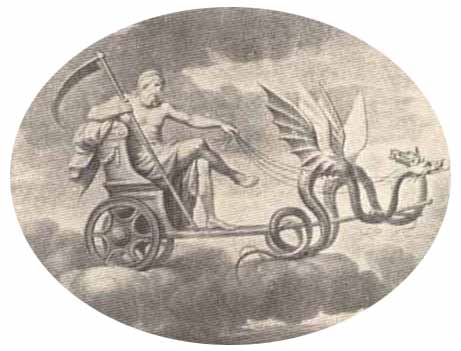
Cronus as Saturn
Time, Omega and Related
In Greek mythology, Crius (Kreios, the "Ram") was one of the Titans in the list given in Hesiod's Theogony, a son of Uranus and Gaia. The least individualized among them, he was overthrown in the Titanomachy. M.L. West has suggested how Hesiod filled out the complement of Titans from the core group, adding three figures from the archaic tradition of Delphi, Koios, Phoibe, whose name Apollo assumed with the oracle, and Themis. Among possible further interpolations among the Titans was Kreios, whose interest for Hesiod was as the father of Perses and grandfather of Hekate, for whom Hesiod is an "enthusiastic evangelist".
Consorting with Eurybia, daughter of Earth Gaia and Sea Pontus, he fathered Astraios and Pallas as well as Perses. The joining of Astraios with Eos, the Dawn, brought forth Eosphoros, the other Stars and the Winds.
Joined to fill out lists of Titans to form a total that made a match with the Twelve Olympians, Crius/Kreios was inexorably involved in the eleven-year-long war between the Olympian gods and Titans, the Titanomachy, however without any specific part to play. When the war was lost, Crius/Kreios was banished along with the others to the lower basement of Hades called Tartarus. From his chthonic position in the Underworld, no classical association with Aries, the "Ram" of the zodiac, is ordinarily made.
In Greek mythology Iapetus, or Iapetos, was a Titan, the son of Uranus and Gaia, and father (by an Oceanid named Clymene or Asia) of Atlas, Prometheus, Epimetheus, and Menoetius and through Prometheus and Epimetheus and Atlas an ancestor of the human race. Iapetus is the one Titan mentioned by Homer in the Iliad (8.478Ð81) as being in Tartarus with Cronus.
Iapetus' wife is normally a daughter of Oceanus and Tethys named Clymene or Asia.
But in Aeschylus's play Prometheus Bound, Prometheus is son of the goddess Themis with no father named (but still with at least Atlas as a brother).
Since mostly the Titans indulge in marriage of brother and sister, it might be that Aeschylus is using an old tradition in which Themis is Iapetus' wife but that the Hesiodic tradition preferred that Themis and Mnemosyne be consorts of Zeus alone. But it would be been quite within Achaean practice for Zeus to have taken the wives of the Titans as his mistresses after throwing down their husbands.
Iapetus is sometimes equated by Creationists with Japheth, the son of Noah, based on the similarity of their names, though scholars of Indo-European linguistics dispute such an equation vehemently.
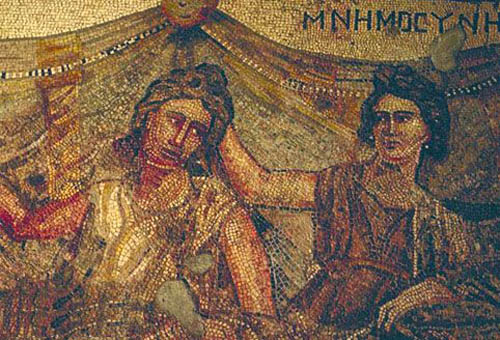
�Mnemosyne (sometimes confused with Mneme or compared with Memoria) was the personification of memory in Greek mythology. This titaness was the daughter of Gaia and Uranus and the mother of the Muses by Zeus. In Hesiod's Theogony, kings and poets receive their powers of authoritative speech from their possession of Mnemosyne and their special relationship with the Muses.
Zeus and Mnemosyne slept together for nine consecutive nights and thereby created the nine muses. Mnemosyne was also the name for a river in Hades, counterpart to the river Lethe, according to a series of 4th century BC Greek funerary inscriptions in dactylic hexameter. Dead souls drank from Lethe so they would not remember their past lives when reincarnated. Initiates were encouraged to drink from the river Mnemosyne when they died, instead of Lethe. These inscriptions may have been connected with a private mystery religion, or with Orphic poetry (see Zuntz, 1971).
Similarly, those who wished to consult the oracle of Trophonius in Boeotia were made to drink alternately from two springs called "Lethe" and "Mnemosyne". An analogous setup is described in the Myth of Er at the end of Plato's Republic.
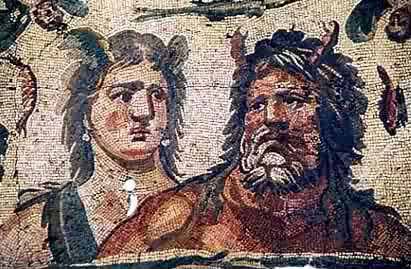
In Greek mythology, Tethys was a Titaness and sea goddess who was both sister and wife of Oceanus. She was mother of the chief rivers of the universe, such as the Nile, the Alpheus, the Maeander, and about three thousand daughters called the Oceanids.
Tethys, along with her husband Oceanus, ruled the seas before Poseidon; Roman mosaic from Daphne (near Antioch) made in the 4th century A.D.Tethys, a Titan sea-goddess who ruled the seas with her husband Oceanus; Roman mosaic from Antioch (House of Calendar) made between the 2nd and 3rd centuries A.D.During the war against the Titans, Tethys raised Rhea as her god-child.Tethys is sometimes confused with Thetis, the wife of Peleus and mother of Achilles.
Hera was not pleased with the placement of Callisto and Arcas in the sky, as the constellations Ursa Major and Ursa Minor, so she asked her nurse, Tethys, to help. Tethys, a marine goddess, cursed the constellations to forever circle the sky and never drop below the horizon, hence explaining why they are circumpolar.
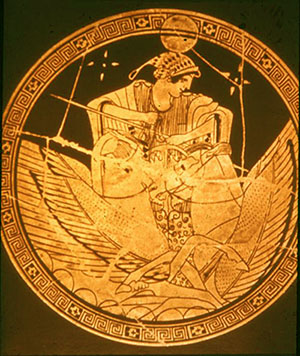
In Greek mythology, Theia (also written Thea or Thia), also called Euryphaessa ("wide-shining"), was a Titan. With her brother and husband Hyperion, she was the mother of Helios (the Sun), Selene (the Moon) and Eos (the Dawn). According to the Homeric Hymn to Helios, Eryphaesa is listed as their mother. The name Theia alone, means simply "goddess," Theia Euryphaessa with overtones of brightness.
She seems here a goddess of glittering in particular and of glory in general, but Pindar's allusion to her as "Theia of many names" is telling, since it suggests assimilation not only to similar mother-of-the-sun goddess like Phoebe and Leto, but perhaps also to more universalizing mother-figures like Rhea and Cybele.
Theia's mythological role as the mother of the Moon goddess Selene is referenced in the application of the name to a hypothetical planet which, according to one theory, collided with the Earth, resulting in the Moon's creation.
Theia in Modern Paganism
Modern interpretations of Theia by many Neopagans, particularly sects in the United States, include the interpretation that she is the all seeing sister of Hyperion. Theia is sometimes seen as a kind and beautiful goddess, but her blessings are sometimes to be feared.
Worship of Theia may include prostration, and the burning of oils and incense, particularly at dawn or dusk. Worship of Theia is not as common as worship of many other Hellenistic gods. Some sects believe that Theia can grant the ability to see ghosts and spirits, as well as other forms of clairvoyance. Because of this many sects that worship Theia also encourage experimentation with the paranormal.
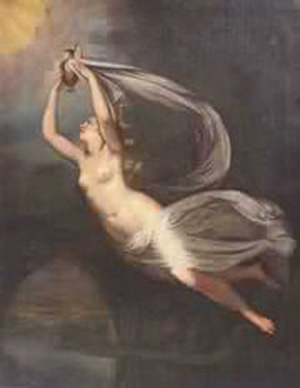
Phoebe, in her name simply the feminine counterpart of Phoebus, was one of the original Titans, one set of sons and daughters of Uranus and Gaia in Greek mythology. She was traditionally associated with the moon (see Selene), as in Michael Drayton's Endimion and PhÏbe, (1595), the first extended treatment of the Endymion myth in English. Her consort was her brother Coeus, with whom she had three children, Leto, Asteria and Hekate.
Through Leto she was the grandmother of Apollo and Artemis. The names Phoebe and Phoebus came to be applied as a synonym for Artemis and an epithet of Apollo. According to a speech that Aeschylus, in Eumenides, puts in the mouth of the Delphic priestess herself, she received control of the Oracle at Delphi from Themis: "Phoebe in this succession seems to be his private invention," D.S. Robertson noted, reasoning that in the three great allotments of oracular powers at Delphi, corresponding to the three generations of the gods, "Ouranos, as was fitting, gave the oracle to his wife Gaia and Kronos appropriately allotted it to his sister Themis." In Zeus' turn to make the gift, however, Aeschylus could not report that the oracle was given directly to Apollo, who had not yet been born, Robertson notes, and thus Phoebe was interposed. These supposed male delegations of the powers at Delphi are not borne out by the usual reconstruction of the sacred site's pre-Olympian history.
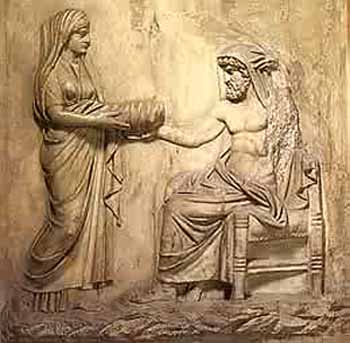
Rhea (or Ria meaning "she who flows") was the Titaness daughter of Uranus and of Gaia. She was sister to Cronus and mother to Demeter, Hades, Hera, Hestia, Poseidon, and Zeus. She was strongly associated with Cybele. In Roman mythology, she was Magna Mater deorum Idaea and identified with Ops.In art, Rhea was usually depicted on a chariot drawn by two lions, not always distinguishable from Cybele.
Her husband, Cronus, castrated their father, Uranus. After this, Cronus re-imprisoned the Hecatonchires, the Gigantes and the Cyclopes and set the monster Campe to guard them. He and Rhea took the throne as King and Queen of the gods. This time was called the Golden Age as the people of the time had no need for laws or rules; everyone did right and as such, there was no need.
Cronus sired several children by Rhea: Hestia, Demeter, Hera, Hades, Poseidon, but swallowed them all as soon as they were born, since he had learned from Gaia and Uranus that he was destined to be overcome by his own son as he had overthrown his own father. But when Zeus was about to be born, Rhea sought Uranus and Earth to devise a plan to save him, so that Cronus would get his retribution for his acts against Uranus and his own children. Rhea gave birth to Zeus in Crete, handing Cronus a stone wrapped in swaddling clothes which he promptly swallowed.
Then she hid Zeus in a cave on Mount Ida in Crete. According to varying versions of the story:
2. He was suckled by a goat named Amalthea, while a company of Kouretes, soldiers, or smaller gods danced, shouted and clapped their hands to make noise so that Cronus would not hear the baby's cry.
3. He was raised by a nymph named Adamanthea. Since Cronus ruled over the earth, the heavens and the sea, she hid him by dangling him on a rope from a tree so he was suspended between earth, sea and sky and thus, invisible to his father.
In Greek mythology, Zeus forced the Titan Cronus to disgorge the other children in reverse order of swallowing: first the stone, which was set down at Pytho under the glens of Parnassus to be a sign to mortal men, then the rest. In some versions, Metis gave Cronus an emetic to force him to disgorge the babies, or Zeus cut Cronus' stomach open. Then Zeus released the brothers of Cronus, the Gigantes, the Hecatonchires and the Cyclopes, who gave him thunder and the thunderbolt and lightning, which had previously been hidden by Gaia. Together, Zeus and his brothers and sisters with the Gigantes, Hecatonchires and Cyclopes overthrew Cronus and the other Titans.
In Homer, Rhea is the mother of the gods, though not a universal mother like Cybele, the Phrygian Great Mother, with whom she was later identified. The original seat of her worship was in Crete. There, according to legend, she saved the new-born Zeus, her sixth child, from being devoured by Kronos, by substituting a stone for the infant god and entrusting him to the care of her attendants the Curetes.
These attendants afterwards became the bodyguard of Zeus and the priests of Rhea, and performed ceremonies in her honour. In historic times, the resemblances between Rhea and the Asiatic Great Mother, Phrygian Cybele, were so noticeable that the Greeks accounted for them by regarding the latter as only their own Rhea, who had deserted her original home in Crete and fled to the mountain wilds of Asia Minor to escape the persecution of Kronos (Strabo. 469, 12). The reverse view was also held (Virgil, Aeneid iii), and it is probably true that cultural contacts with the mainland brought to Crete the worship of the Asiatic Great Mother, who became the Cretan Rhea.
In Greek mythology, Rhea's symbol is the moon. However, in Roman mythology, her symbol is known as the lunar (which would seem to mean "Moon"). She has another symbol, the swan, because it is a gentle animal. Also, her other symbol is two lions, supposedly the ones that pull her chariot .
In Greek mythology, Hesiod mentions Themis among the six sons and six daughters - of whom Cronos was one - of Gaia and Ouranos, that is, of Earth with Sky. Among these Titans of primordial myth, few were venerated at specific sanctuaries in classical times, and Themis was so ancient that the followers of Zeus claimed that it was with him she produced the Three Fates themselves (Hesiod, Theogony, 904).
A fragment of Pindar, however, tells that the Moerae were already present at the nuptials of Zeus and Themis, that in fact the Moerae rose with Themis from the springs of Okeanos the encircling World-Ocean and accompanied her up the bright sun-path to meet Zeus at Olympus. With Zeus she more certainly bore the Horae, those embodiments of the right moment - the rightness of Order unfolding in Time - and Astraea. Themis was there at Delos to witness the birth of Apollo.
Themis (meaning "law of nature" rather than "human ordinance"), she "of good counsel," was the embodiment of divine order, law and custom. When Themis is disregarded, Nemesis brings just and wrathful retribution. Themis is not wrathful: she, "of the lovely cheeks" was the first to offer Hera a cup when she returned to Olympus distraught over threats from Zeus (Iliad xv.88). Themis presided over the proper relation between man and woman, the basis of the rightly ordered family, and the family the pillar of the deme, and judges were often referred to as "themistopoloi" (the servants of Themis). Such was the basis for order upon Olympus too. Hera addressed her as "Lady Themis."
The name of Themis might be substituted for Adrasteia in the birth of Zeus on Crete. She built the Oracle at Delphi and was herself oracular. Themis was one of the gods behind the Oracle at Delphi, which she received from Gaia and gave to Phoebe.
Many modern Neopagans, particularly Hellenistic Neopagans, believe that Themis is the goddess of virtue and justice. In many modern sects Themis is thought to take part in deciding the afterlife of one's mortal spirit. She carries a set of scales which weigh a persons virtuous deeds against a persons ill deeds. Themis is also thought to give the final input before the fate of a mortal is decided by Hades (The Judge).
Themis is often considered compassionate and virtuous towards mortals, and concerned with mortal wellbeing as well as mortal plights. Worship of Themis is not uncommon among many pagan sects in the United States, according to some pagan websites Themis may have as many worshippers that Artemis or Hera (two of the most popular pagan gods). Worshippers of Themis often attempt to lead virtuous and charitable lives.
Worship of Themis may take the form of chants, prayer, the burning of oils and incense, and the burning of food or spilling of drinks as offerings. Acts of Charity are also considered to be an active form of worship. Some sects that include worship of Themis encourage tithing, and many encourage proselytizing to non-believers. Proselytizing is typically rare among sects that do not include the worship of Themis. Followers of Themis often discourage hedonism, persecution, grudges, malice, spite, mockery, and revenge. Themis is thought to grant boons of good health, euphoria, virility, and charisma to her followers. Some pagan websites suggest that Themis is most commonly worshipped by males.
Asteria was the daughter of the Titan gods Coeus and Phoebe and sister of Leto. Asteria flung herself into the ocean in the form of a quail in order to escape the advances of Zeus. She became the island of the same name. By Zeus she became the mother of Heracles (not to be confused with the Greek demi-god) who was worshipped at Tyre. By Perses she had a daughter Hecate. Later, the island Asteria was identified with Delos, which was the only piece of earth to give refuge to the fugitive Leto when, pregnant with Zeus's children, she was pursued by vengeful Hera.
In Greek mythology, Astraeus is an astrological deity. His original Greek name, Astraios, translates to "Starry". In Hesiod's Theogony and in the Bibliotheca, Astraeus is a second-generation Titan, descended from Crius and Eurybia. However, Hyginus wrote that he was descended directly from Tartarus and Gaia, and referred to him as one of the Gigantes.
The wife of Astraeus is Eos, the goddess of the dawn, and their sons include the four Anemoi ("Winds"), Boreas, Notus, Eurus, and Zephyrus, and the five Astra Planeta ("Wandering Stars", i.e. planets), Phainon (Saturn), Phaethon (Jupiter), Pyroeis (Mars), Eosphoros/Hesperos (Venus), and Stilbon (Mercury). A few sources mention one daughter, Astraea, but most writers considered Astraea the child of Zeus and Themis.
He is sometimes associated with Aeolus, the Keeper of the Winds.

Atlas was the son of Iapetus and the nymph Clymene, and brother of Prometheus. He was the father of the Hesperides, Maera, the Hyades, Calypso and the Pleiades. Atlas led the Titans in a war against the gods of Mount Olympus. When the Titans were defeated, Zeus punished him with the burden of carrying the heavens upon his shoulders. Atlas was turned to stone by Perseus using Medusa's head in the place where the Atlas mountains now stand, after he threatened Perseus when wanting to speak to his father Zeus about the punishment that had fallen upon him. He is also known as one of the founding kings of Atlantis.
Atlas was tricked by the hero Heracles, one of whose Twelve Labors involved the retrieval of some of the golden apples of the Hesperides; Heracles offered to hold the heavens for a little while in exchange for the apples, and Atlas agreed. Upon his return with the apples, however, Atlas refused to take the heavens back from Heracles. Heracles then tricked the giant again by agreeing to take his place if he would only take the sky again for a few minutes so Heracles could rearrange his cloak as padding on his shoulders. When Atlas took the heavens upon his shoulders again, Heracles left
The etymology of the name Atlas is uncertain and still debated: some derive it from the Proto-Indo-European root 'tel', 'to uphold, support'; others suggest that it is a pre-Indo-European name. Since the Atlas mountains fall in the region inhabited by Berbers, it could be that the latin name as we know it is taken from Berber.
In fact, the sun is often called the 'eye of the sky'.
And since it sets to the west, the Atlantic ocean can be called "the place of concealement of the sun" or Antal n Tit. Greeks could have borrowed this name for the ocean and called it Atlantic, and later used its root ATL to form the name Atlas."Atlas" is also the presently used name of many objects and places (see Atlas (disambiguation)).
Since the middle of the sixteenth century, he is often shown in cartographic atlases. However it was not he but rather the mythical King Atlas that was depicted by Mercator in the first book to bear the name "atlas" and who gave his name to that type of book.
Atlas continues to be a commonly used icon in western culture (and advertising), as a symbol of strength or stoic endurance such as the superhero, Captain Marvel who was granted the stamina of Atlas as part of his powers. In such contemporary depictions, he is often shown kneeling over on one knee while supporting an enormous round globe on his back and shoulders. (The depiction of Atlas holding a large round disk on his back is more accurate, however, since the Greeks believed that the world was flat.)
The image of Atlas bearing a great burden was used by the author Ayn Rand in her novel Atlas Shrugged, which serves as an important metaphor throughout the novel. A character in the novel says that Atlas is "the giant who holds the world on his shoulders", although Atlas actually held the heavens and not the Earth.
In Greek mythology, Clymene or Klymene ("famous might") is the name of at least six possibly distinct females.
An Oceanid also called Asia, the wife of Iapetus. Mother of Atlas, Epimetheus, Prometheus, and Menoetius.
An Oceanid, mother of Phaethon by Helios, sometimes as a full wife and mother also of the Heliades (essentially equated with Rhode) and sometimes as wife of Merops with whom Helios secretly lay.
Mother of Deucalion by Prometheus. Possibly one of the above two (parent-child couplings occasionally occur among the earliest deities in Greek myth).
Wife of Merops and Queen of Ethiopia, mother of Pandareus, possibly the same as the previous.
Mother of Atalanta and wife of Schoeneus or Iasus
Grandaughter of Minos and mother of Palamedes by Nauplius.
By Ares, mother of Diomedes
Dione in Greek mythology is a vague goddess presence who has her most concrete form in Book V of Homer's Iliad as the mother of Aphrodite: Aphrodite journeys to Dione's side after she has been wounded in battle while protecting her favorite son Aeneas.
In this episode, Dione seems to be the equivalent of Rhea the Earth Mother, whom Homer also placed in Olympus. Dione's Indo-European name is really less a name than simply a title: the "Goddess", etymologically a female form of Zeus. Roman "Diana" has a similar etymology but is not otherwise connected with Dione.
After the Iliad, Aphrodite herself was sometimes referred to as "Dionaea" and even "Dione", just "the goddess" (Peck 1898). At the very ancient oracle of Zeus at Dodona, Dione rather than Hera, was the goddess resorted to in the company of Zeus, as many surviving votive inscriptions show.
Although Dione is not a Titan in Hesiod, but appears instead in his Theogony among the long list of Oceanids, Apollodorus includes her among the Titans (1.1.3 and 1.3.1).
A later mythographer, Hyginus, (Fabulae 82, 83) says that Dione is a daughter of Atlas and the mother, by Tantalus, of Pelops, Niobe and Broteas.
In Greek mythology, Epimetheus was the son of Iapetus and brother of Prometheus and Atlas; "Epimetheus" is Greek for "hindsight."
He was responsible for giving a positive trait to every animal, but when it was time to give man a positive trait, there was nothing left. His brother Prometheus then stole fire from Zeus and gave it to man. As punishment, Zeus created Pandora for Epimetheus, knowing that he would fall in love with her despite the warnings of his more intelligent brother, who told him never to accept a gift from the Olympian gods ("Prometheus" means "foresight").
Epimetheus and Pandora were married. Pandora had been given a box by Hermes and was instructed never to open it. However, Hermes also gave her curiosity, and she opened it anyway releasing all the misfortunes of mankind. She shut it in time to keep one thing in the box: hope. Thus mankind always has hope in times of evil.
The daughter of Epimetheus and Pandora was Pyrrha, who married Deucalion and was one of the two who survived the deluge.
Hyperion is the Titan of light, an early sun god. He is the son of Gaea and Uranus. He married his sister Theia the Goddess of Sight. Their children are Helius (the sun), Selene (the moon), and Eos (the dawn). In the Homer's Iliad and Odyssey the sun god is called Helios Hyperion, 'Sun High-one'. But in the Odyssey, Hesiod's Theogony and the Homeric Hymn to Demeter the sun is once in each work called Hyperonides 'son of Hyperion' and Hesiod certainly imagines Hyperion as a separate being in other places.
In later Greek literature Hyperion is always distinguished from Helios as a Titan, the son of Gaia 'Goddess Earth' and Uranus 'God Sky', and the father of Helios 'God Sun', Selene 'Goddess Moon' and Eos 'Goddess Dawn' by his sister Theia 'Goddess Sight'.
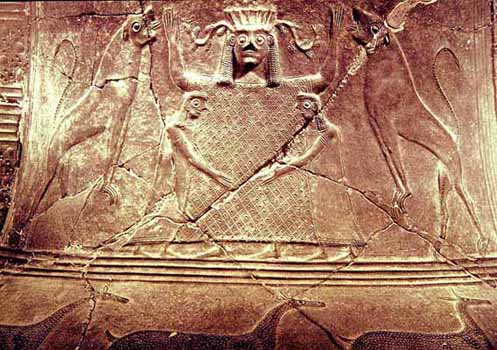
In Greek mythology, Leto is a daughter of the Titans Coeus and Phoebe: Kos claimed her birthplace. In the Olympian scheme of things, Zeus is the father of her twins, Apollo and Artemis, the Letoides. Leto is scarcely to be conceived apart from being pregnant and finding a suitable place to be delivered of Apollo, the second of her twins. This is her one active mythic role: once Apollo and Artemis are grown, Leto withdraws, to remain a dim and benevolent matronly figure upon Olympus, her part already played.
In Roman mythology her equivalent, as mother of Apollo and Diana, is Latona.
In Crete, at the city of Dreros, Spyridon Marinatos uncovered an eighth-century post-Minoan hearth house temple in which there were found three unique figures of Apollo, Artemis and Leto made of brass sheeting hammered over a shaped core. Walter Burkert notes (in Greek Religion) that in Phaistos she appears in connection with an initiation cult. Leto was the principal goddess of Anatolian Lycia. Her sanctuary, the Letoon near Xanthos, united the Lycian confederacy of city-states. The people of Cos also claimed Leto as their own.
A measure of what a primal goddess Leto was can be recognized in her father and mother. Her Titan father is called "Coeus," and his name links him to the sphere of heaven from pole to pole. Leto's mother "Phoebe" is precisely the "pure" and "purifying" epithet of the full moon.
Several explanations have been put forward to explain the origin of the goddess and the meaning of her name. Some have seen her as an importation of the ancient Middle Eastern deity Al Latu, Latu meaning Goddess in classical Arabic (Allatu is the feminine form of Allah).
It has also been proposed that the name "Leto" originates from the verb "lanthanein" (to be concealed or oblivious) that also gives "lethe" (oblivion) and "Lotus" (the fruit that brings oblivion to those who eat it). It would thus mean "the hidden one".
Others say it comes from the same origin as "Leda", meaning "woman/wife" in ancient Lydian.
When Hera, the most conservative of goddesses - for she had the most to lose in changes to the order of nature Ñ discovered that Leto was pregnant and that Zeus was the father, she realized that the offspring would cement the new order. She was powerless to stop the flow of events, but she banned Leto from giving birth on "terra firma", the mainland, any island at sea, or any place under the sun.
Some mythographers hinted that Leto came down from the land of the Hyperboreans in the guise of a she-wolf, or that she sought out the "wolf-country" of Lycia for her denning. Most accounts agree that she found the barren floating island of Delos, which was neither mainland nor a real island, and gave birth there, promising the island wealth from the worshippers who would flock to the obscure birthplace of the splendid god who was to come. The island was surrounded by swans. As a gesture of gratitude, Delos was secured with four pillars and later became sacred to Apollo.
It is remarkable that Leto brought forth Artemis, the elder twin, without struggle or pain - as if she were merely revealing another manifestation of herself. Leto labored for nine nights and nine days for Apollo, according to the Homeric Hymn to Delian Apollo, in the presence of all the first among the deathless goddesses as witnesses: Dione, Rhea, Ichnaea, Themis and the "loud-moaning" sea-goddess Amphitrite. Only Hera kept apart, perhaps to kidnap Eileithyia or Ilithyia, the goddess of childbirth, to prevent Leto from going into labor. Instead Artemis, having been born first, assisted with the birth of Apollo. Another version states that Artemis was born one day before Apollo, on the island of Ortygia, and that she helped Leto cross the sea to Delos the next day to give birth to Apollo.
Leto was threatened and assailed in her wanderings by chthonic monsters of the ancient earth and old ways, and these became the enemies of Apollo and Artemis. One was the Titan Tityos, a phallic being who grew so vast that he split his mother's womb and had to be carried to term by Gaia herself. He attempted to waylay Leto near Delphi, but was laid low by the arrows of Apollo - or possibly Artemis, as another myth-teller recalled.
Another ancient earth creature that had to be overcome was the dragon Pytho, or Python, which lived in a cleft of the mother-rock beneath Delphi and beside the Castalian Spring. Apollo slew it but had to do penance and be cleansed afterwards, since Python was a child of Gaia. Sometimes the slaying was said to be because Python had attempted to rape Leto while pregnant with Apollo and Artemis, but one way or another, it was necessary that the ancient Delphic Oracle pass to the protection of the new god.
A Queen of Thebes and wife of Amphion, Niobe boasted of her superiority to Leto because she had fourteen children (Niobids), seven male and seven female, while Leto had only two. For her hubris, Apollo killed her sons as they practiced athletics, with the last begging for his life, and Artemis her daughters. Apollo and Artemis used poisoned arrows to kill them, though according to some versions a number of the Niobids were spared (Chloris, usually). Amphion, at the sight of his dead sons, either killed himself or was killed by Zeus after swearing revenge. A devastated Niobe fled to Mount Sipylus in Asia Minor and either turned to stone as she wept or killed herself. Her tears formed the river Achelous. Zeus had turned all the people of Thebes to stone so no one buried the Niobids until the ninth day after their death, when the gods themselves entombed them.
Leto was intensely worshipped in Lycia, Asia Minor. In Delos and Athens she was worshipped primarily as an adjunct to her children. Herodotus reported hearsay of a temple to her in Egypt attached to a floating island called "Khemmis" in Buto, which also included a temple to Apollo. There, Leto was wosrhipped in the form of Wadjet, the cobra-headed goddess of lower Egypt. However, Herodotus didn't believe in the existence of either temple.
According to the Homeric hymn, the goddesses who assembled to be witnesses at the birth of Apollo were responding to a public occasion in the rites of a dynasty, where the authenticity of the child must be established beyond doubt from the first moment. The dynastic rite of the witnessed birth must have been familiar to the hymn's 8th-century hearers. The dynasty that is so concerned to be authenticated in this myth is the new dynasty of Zeus and the Olympian Pantheon, and the goddesses at Delos who bear witness to the rightness of the birth are the great goddesses of the old order. Demeter is not present; her mother Rhea attends. Aphrodite, a generation older than Zeus, is not present either. The goddess Dione (in her name simply the "Goddess") is sometimes taken by later mythographers as a mere feminine form of Zeus (see entry Dodona): if this were so, she would not have assembled here.
Pindar calls the goddess Leto Chryselakatos (Sixth Nemean Ode, 36), an epithet that was attached to her daughter Artemis as early as Homer. "The conception of a goddess enthroned like a queen and equipped with a spindle seems to have originated in Asiatic worship of the Great Mother", O. Brendel notes, but a lucky survival of an inscribed inventory of her temple on Delos, where she was the central figures of the Delian trinity, records her cult image as sitting on a wooden throne, clothed in a linen chiton and a linen himation.
According to Ovid's Metamorphoses, when Leto was wandering the earth after giving birth to Apollo and Artemis, she attempted to drink water from a pond in Lycia. The peasants there refused to allow her to do so by stirring the mud at the bottom of the pond. Leto turned them into frogs for their inhospitality, forever doomed to swim in the murky waters of ponds and rivers. This scene is represented in the central fountain, the Bassin de Latone, in the garden terrace of Versailles.
In Greek mythology, Metis was of the Titan generation and, like several primordial figures, an Oceanid, in the sense that Metis was born of Oceanus and Tethys, of an earlier age than Zeus and his siblings. Metis was the first great spouse of Zeus, indeed his equal (Hesiod, Theogony 896) and the mother of Athena, the goddess of war and wisdom. By the era of Greek philosophy Metis had become the goddess of wisdom and deep thought, but her name originally connoted "magical cunning" and was as easily equated with the trickster powers of Prometheus as with the "royal metis" of Zeus. The Stoic commentators allegorized Metis as the embodiment of "wisdom" or "wise counsel", in which form she was inherited by the Renaissance.
Metis was both a threat to Zeus and an indispensable aid. In order to forestall these dire consequences, Zeus tricked her into turning herself into a fly and promptly swallowed her. He was too late: Metis had already conceived a child. In time she began making a helmet and robe for her fetal daughter. The hammering as she made the helmet caused Zeus great pain and Prometheus, Hephaestus, Hermes, or Palaemon (depending on the sources examined) either cleaved Zeus's head with an axe, or hit it with a hammer at the river Triton, giving rise to Athena's epithet Tritogeneia. Athena leaped from Zeus's head, fully grown, armed, and armored, and Zeus was none the worse for the experience. The similarities between Zeus swallowing Metis and Cronus swallowing his children have been noted by several scholars.
The second consort taken by Zeus, according to the Theogony was Themis, "right order". Hesiod's account is followed by Acusilaus and the Orphic tradition, which enthroned Metis side by side with Eros as primal cosmogenic forces. Plato makes poros, or "creative ingenuity", the child of Metis.


�In Greek mythology, Prometheus is the Titan chiefly honored for stealing fire from Zeus in the stalk of a fennel plant and giving it to mortals for their use. For that, Zeus ordered him to be chained on top of the Caucasus. Every day an eagle would come and eat his liver, but since Prometheus was immortal, his liver always grew back, so he was left to bear the pain every day. He is depicted as an intelligent and cunning figure who had sympathy for humanity. To this day, the term Promethean refers to events or people of great creativity, intellect, and boldness.
As a god of fire, burning, and craft, Prometheus had a small shrine in the Keramikon, or potter's quarter, of Athens, not far from Plato's Academy.
Prometheus was a son of Iapetus by Clymene (one of the Oceanids). He was a brother of Atlas, Menoetius, and Epimetheus. He surpassed all in cunning and deceit. He held no awe for the gods, and he ridiculed Zeus and Zeus's lack of insight and fought alongside of the gods against the Titans.
Prometheus was the creator of man. When he and Epimetheus (hindsight) set out to make creatures to populate the earth under the orders of Zeus, Epimetheus went with quantity and made many creatures, endowing them with many gifts that were alotted to the brother for that purpose (fur, claws, wings, and fins were some of these gifts). While his brother was making creatures, Prometheus was carefully crafting a creature after the shape of the gods. It was a human.
However, Prometheus took so long in crafting his masterpiece that when he was finished, Epimetheus had already used up all the gifts from Zeus. Prometheus was sorry for his creations, and watched as they shivered in the cold winter nights.
He decided to steal fire from the gods after Zeus disagreed with his idea of helping the humans. He climbed Olympus and stole fire from the chariot of Helios (or, in later mythology, Apollo). He carried the fire back in the stalk of a fennel plant, which burns slowly and so was appropriate for this task. Thus mankind was warm.
To appease Zeus, Prometheus told the humans to burn offerings to the gods. He killed a great bull for this purpose. When the gods smelled the offerings, Prometheus decided to play a trick on the gods. The meat he hid beneath a layer of bone and sinew, whilst the bones he disguised with delicious-looking fat. He then offered Zeus his choice of "meat" for the gods to eat. Zeus picked the plate of bones, and Prometheus took the plate of meat for himself and the mortals.
To punish Prometheus for this hubris (and all of mankind in the process), Zeus took fire away from the earth.

Vulcan Chaining Prometheus
To get revenge on Prometheus for his continued offenses, Zeus had Hephaestus (Vulcan) make a woman made of clay named Pandora. Zeus brought her to life and sent her to Prometheus, along with a jar with all the valuable presents she had received from the gods in it. Prometheus was suspicious and would have nothing to do with Pandora, claiming that she was foolish (lacking foresight), and she was sent on to Epimetheus, who married her.
Zeus was further enraged by Prometheus's escape and had Prometheus carried to Mount Caucasus, where an eagle by the name of Ethon (offspring of the monsters Typhon and Echidna) would eat out his liver; it would grow back each day and the eagle would eat it again.
This punishment was to last 30,000 years. About 30 years into the punishment, Heracles, passing by on his way to find the apples of the Hesperides as part of the Twelve Labors, freed Prometheus, in a bargain he had agreed with Zeus in exchange for Chiron's immortality, by shooting the eagle with an arrow.
Zeus did not mind this time that Prometheus had again evaded his punishment, as the act brought more glory to Heracles, who was Zeus's son. Prometheus was invited to return to Olympus, though he still had to carry with him the rock that he was chained to.
As the introducer of fire and inventor of sacrifice he is seen as the patron of human civilization. Uncertain sources claim he was worshipped in ancient Rome.
He was the father of Deucalion with Celaeno. Epimetheus, the husband of Pandora, was his brother.
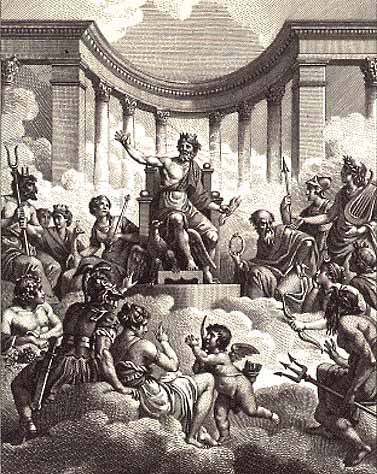
Gods and Goddesses of Olympus